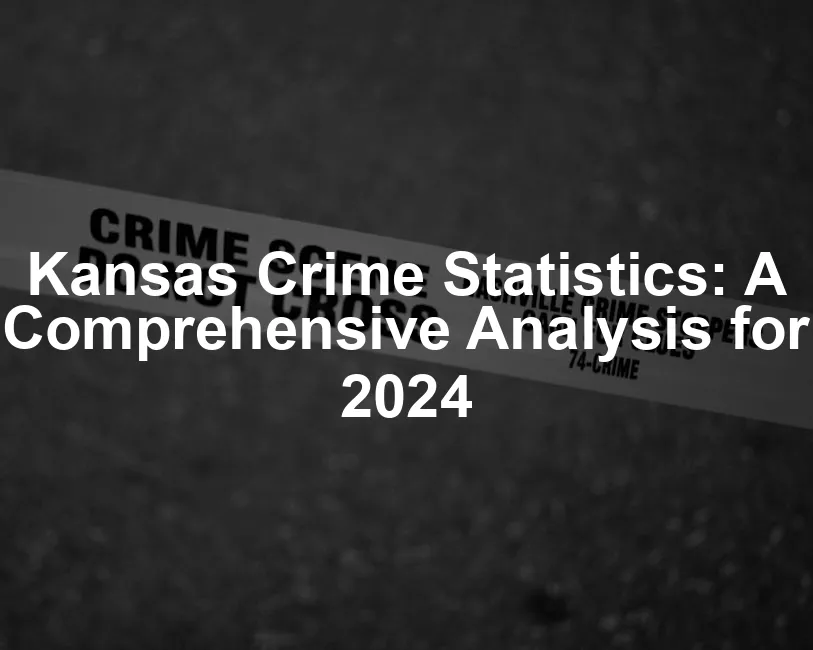Introduction
Kansas has seen a mixed bag of crime trends recently. In 2023, violent crime dipped by 3.7%, while property crime experienced an unexpected rise of 2.6%. This curious combination raises eyebrows and prompts discussion. Understanding these shifts is crucial for residents, policymakers, and law enforcement alike.
Why should we care about crime statistics? Well, they paint a picture of safety in our communities. When residents have a clear grasp of crime trends, they can make informed decisions about their safety and engage with local law enforcement effectively. Policymakers can use this data to allocate resources wisely, targeting areas that need help the most.
The data presented in this overview comes from reliable sources, including the Kansas Bureau of Investigation (KBI) and local law enforcement agencies. They compile crime statistics using the Kansas Incident-Based Reporting System (KIBRS). This system gathers detailed reports from law enforcement, ensuring the statistics are as accurate and comprehensive as possible. By analyzing this data, we can better understand crime in Kansas and work towards a safer future for all.

Understanding Kansas Crime Statistics
What Are Crime Statistics?
Crime statistics are numerical representations of reported crimes within a specific area. They help us identify trends and patterns, ultimately shaping public safety initiatives. Understanding crime statistics is vital, as they allow residents to gauge their safety and empower law enforcement to address issues effectively.
Crimes fall into two primary categories: violent and property crimes. Violent crimes include offenses like murder, rape, robbery, and aggravated assault. These crimes often evoke fear and concern within communities. On the other hand, property crimes encompass burglary, theft, and motor vehicle theft. While these crimes may not directly harm individuals, they can significantly disrupt community well-being.
Analyzing these statistics also helps identify emerging trends. For example, if property crime rates rise, law enforcement can respond with targeted efforts to deter criminal activity. In short, crime statistics are not just numbers; they serve as crucial tools for enhancing community safety and welfare.

Data Collection Methods
Understanding how crime data is collected in Kansas is essential for interpreting statistics accurately. The Kansas Bureau of Investigation (KBI) plays a crucial role. This agency gathers crime reports from local law enforcement agencies statewide. These reports provide a detailed look at various types of crimes occurring across the state.
One of the primary tools used for this collection is the Kansas Incident-Based Reporting System (KIBRS). This system is designed to capture comprehensive details about each crime reported, including the nature of the offense and the demographics of both victims and offenders. By using KIBRS, law enforcement agencies can submit precise data that reflects the realities of crime in their communities. This method ensures a more nuanced and thorough understanding of crime trends.
The data compiled by KBI serves not only as a historical snapshot but also as a practical resource for policymakers and law enforcement. By analyzing this information, they can identify patterns, allocate resources effectively, and develop strategies to enhance community safety.

Recent Trends in Crime Statistics
2023 Crime Statistics Overview
The 2023 Kansas Crime Index Report reveals intriguing trends in crime rates. Overall, the state recorded a total of 70,693 crimes, a figure that reflects a complex dynamic between violent and property crimes. Notably, violent crime saw a decrease of 3.7%, while property crime increased by 2.6%.
Breaking it down further, the report indicates that there were 12,178 violent crimes reported, translating to a rate of 4.15 per 1,000 residents. This includes serious offenses such as murder, rape, robbery, and aggravated assault. On the property crime front, a staggering 58,515 incidents were recorded, which comes to a rate of 19.92 per 1,000 residents.
This juxtaposition of decreasing violent crime alongside rising property crime raises important questions about the underlying factors influencing these trends. Understanding the broader context of crime in neighboring states can also provide valuable insights. For a deeper look into crime statistics in a similar region, check out this analysis of arkansas crime statistics.
Understanding crime trends can provide essential insights for residents and policymakers. arkansas crime statistics offer a comparative perspective.

Violent Crime Analysis
In 2023, the breakdown of violent crimes reported in Kansas is as follows:
- Murder: 134 cases (0.05 per 1,000 residents)
- Rape: 1,335 cases (0.45 per 1,000 residents)
- Robbery: 859 cases (0.29 per 1,000 residents)
- Assault: 9,850 cases (3.35 per 1,000 residents)
When we compare these statistics with the previous three years, we see a downward trend in violent crimes. For instance, in 2022, violent crimes totaled 12,654, marking a significant decline in 2023. This drop continues a pattern observed over the past decade, where violent crime rates have fluctuated but generally trended downward.
However, there’s a twist. While the statewide average shows improvement, certain cities like Topeka and Wichita have experienced spikes in specific violent crime categories. Topeka, for example, recorded 34 murders in 2023, more than doubling its figures from 2022. This contrasts with the statewide decrease, showcasing the localized nature of crime trends.
This analysis not only highlights a broader decline in violent crime but also underscores the importance of understanding localized trends. Each city has its unique challenges, and addressing these requires tailored strategies.
In summary, while Kansas as a whole has seen a reduction in violent crime, cities experiencing spikes indicate that the fight against crime is far from over. It’s essential for local law enforcement and communities to remain vigilant and proactive in addressing these challenges to maintain a safer environment for all residents.

Property Crime Analysis
In 2023, property crime in Kansas took an unexpected turn, rising by 2.6%. This marked the first increase in property crime since 2017, leaving many scratching their heads. The total reported property crimes hit a staggering 58,515, equating to a rate of 19.92 per 1,000 residents. Let’s break it down further.
- Burglary: 8,029 cases (2.73 per 1,000 residents)
- Theft: 43,725 cases (14.89 per 1,000 residents)
- Motor Vehicle Theft: 6,761 cases (2.30 per 1,000 residents)
While property crime surged, it’s worth noting that the national average for property crime stands at 16.54 per 1,000 residents. So, Kansas is still slightly below the national norm. However, the increase in property crime raises questions about safety and community vigilance.
Experts suggest that factors like economic strain and shifts in local law enforcement focus might be contributing to this uptick. The increase in motor vehicle theft, specifically, which rose by 4.8%, indicates a growing concern. Motorists might want to double-check their locks and invest in anti-theft devices! These can provide peace of mind and help reduce the risk of theft.

Analysis of Specific Cities
Most Dangerous Cities
Wichita and Topeka consistently top the charts for crime rates in Kansas, with alarming statistics. Wichita reported 39 murders in 2023, while Topeka saw a staggering 34 murders, more than doubling its count from the previous year. Topeka accounted for 21.7% of the state’s total murders despite housing only 4.2% of Kansas’s population—talk about a disproportionate share!
In terms of overall crime rates, Wichita holds the title for the highest property crime rate in the state, with 2,660 incidents per 100,000 people. Factors contributing to these high rates include socioeconomic challenges, urban density, and, unfortunately, issues related to drug abuse and gang activity.
Residents in these cities face a unique set of challenges. Law enforcement agencies are stepping up their efforts to combat these trends, focusing on community engagement and proactive policing strategies. After all, a safer city is a happier city!

Crime Victimization in Kansas
Understanding Victimization Rates
In Kansas, the likelihood of becoming a crime victim varies. Statistically speaking, your chances of falling victim to a violent crime are about 1 in 241. For property crime, that ratio worsens to 1 in 50. Yes, you read that right—one in fifty!
The numbers tell an interesting story. In 2023, Kansas reported 12,178 violent crimes, translating to a rate of 4.15 per 1,000 residents. Meanwhile, property crimes soared to 58,515 incidents, which equals a staggering rate of 19.92 per 1,000 residents. This stark contrast shows that while violent crimes are declining, property crimes are on the rise.
When we analyze these victimization rates further, we notice that violent crimes include serious offenses like murder, rape, and assault, which understandably raise alarm bells. Conversely, property crimes—ranging from theft to burglary—are often perceived as less threatening, though they can still shake up community peace.

Impact of Crime on Communities
Crime doesn’t just exist in a vacuum; it ripples through communities like a stone tossed into a pond. High crime rates can create a culture of fear, making residents hesitant to venture out, especially at night. This can lead to a decline in community engagement and trust among neighbors.
Imagine living in a neighborhood where you hear sirens more often than children playing outside. Not the ideal scenario, right? Crime impacts not only safety but also the overall quality of life. Property values may drop, local businesses might struggle, and community cohesion often takes a hit.
Crime’s impact extends beyond immediate fear. It can lead to strained relationships with law enforcement. When residents feel unsafe, they may be less likely to report crimes, creating an undercurrent of distrust. To combat these issues, many communities are turning to proactive policing and community engagement strategies.
Programs that encourage collaboration between residents and law enforcement can help rebuild trust. Community initiatives, like neighborhood watch groups, can also foster a sense of ownership and vigilance among residents.
In the end, addressing crime requires a multifaceted approach. It’s not just about statistics; it’s about creating safer, more vibrant communities. The collaboration between law enforcement and residents can transform fear into empowerment, turning neighborhoods into places of safety and trust.

Case Studies
Notable Crime Cases in Kansas
Kansas has seen its fair share of crime cases that have made headlines and, more importantly, shaped public perception. One such case involves the tragic murder of 10-year-old Alayna Ertl in 2014. This heart-wrenching story captured the attention of the entire state. The crime shocked the community and raised concerns about the safety of children in Kansas. It prompted discussions about law enforcement’s role and the effectiveness of crime prevention initiatives.
Another notable case is the 2016 shooting at a Kansas City bar, which left four people dead. This incident highlighted issues of gun violence in urban areas. The aftermath saw community leaders and law enforcement agencies coming together, aiming to develop strategies to curb violence.
These cases taught us valuable lessons. They emphasized the need for comprehensive training for local law enforcement. Engagement with the community became a priority after these tragedies. Law enforcement agencies began collaborating with local organizations to foster trust and open communication with residents.
Additionally, these events sparked initiatives focused on youth outreach programs. The goal? To steer young people away from crime and into positive activities. The community recognized that proactive measures could prevent crime rather than simply reacting to it.
Moreover, the impact of these cases on law enforcement practices is undeniable. With heightened awareness, police departments across Kansas implemented new training programs focused on crisis intervention and community policing. These practices aim to build relationships with the public, creating a safer environment for all.
In recent years, Kansas has witnessed a shift toward data-driven policing. Analyzing crime trends helps law enforcement allocate resources more effectively. This approach allows departments to address specific issues in their communities, enhancing overall safety.

FAQs
What are the most common crimes in Kansas?
In Kansas, property crimes dominate the statistics. The most prevalent offenses include theft, burglary, and motor vehicle theft. In 2023, there were a staggering 58,515 reported property crimes, resulting in a rate of 19.92 per 1,000 residents. Theft: 43,725 cases (14.89 per 1,000 residents) Burglary: 8,029 cases (2.73 per 1,000 residents) Motor Vehicle Theft: 6,761 cases (2.30 per 1,000 residents) On the violent crime side, while less frequent, these offenses still create concern. The most common violent crimes in Kansas include: Assault: 9,850 cases (3.35 per 1,000 residents) Rape: 1,335 cases (0.45 per 1,000 residents) Robbery: 859 cases (0.29 per 1,000 residents) Murder: 134 cases (0.05 per 1,000 residents) This data highlights the importance of community engagement and proactive policing strategies to address these prevalent crimes effectively.
Please let us know what you think about our content by leaving a comment down below!
Thank you for reading till here 🙂 And if you’re looking to delve deeper into the world of crime and justice, consider picking up Crime and Justice: A History of the Criminal Justice System in America. It’s a fascinating read that will give you insights into the complexities of our legal system!
All images from Pexels




